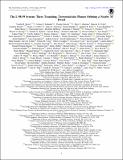| dc.contributor.author | Matthews, Elisabeth | |
| dc.contributor.author | Ricker, George R. | |
| dc.contributor.author | Vanderspek, Roland K. | |
| dc.contributor.author | Seager, Sara | |
| dc.contributor.author | Burke, Chris | |
| dc.contributor.author | Crossfield, Ian | |
| dc.contributor.author | Shporer, Avi | |
| dc.date.accessioned | 2020-04-17T20:16:51Z | |
| dc.date.available | 2020-04-17T20:16:51Z | |
| dc.date.issued | 2019-07 | |
| dc.date.submitted | 2019-03 | |
| dc.identifier.issn | 1538-3881 | |
| dc.identifier.uri | https://hdl.handle.net/1721.1/124742 | |
| dc.description.abstract | We report the Transiting Exoplanet Survey Satellite (TESS) discovery of three terrestrial-size planets transiting L 98-59 (TOI-175, TIC 307210830) - a bright M dwarf at a distance of 10.6 pc. Using the Gaia-measured distance and broadband photometry, we find that the host star is an M3 dwarf. Combined with the TESS transits from three sectors, the corresponding stellar parameters yield planet radii ranging from 0.8 R ⊕ to 1.6 R ⊕. All three planets have short orbital periods, ranging from 2.25 to 7.45 days with the outer pair just wide of a 2:1 period resonance. Diagnostic tests produced by the TESS Data Validation Report and the vetting package DAVE rule out common false-positive sources. These analyses, along with dedicated follow-up and the multiplicity of the system, lend confidence that the observed signals are caused by planets transiting L 98-59 and are not associated with other sources in the field. The L 98-59 system is interesting for a number of reasons: the host star is bright (V = 11.7 mag, K =7.1 mag) and the planets are prime targets for further follow-up observations including precision radial-velocity mass measurements and future transit spectroscopy with the James Webb Space Telescope; the near-resonant configuration makes the system a laboratory to study planetary system dynamical evolution; and three planets of relatively similar size in the same system present an opportunity to study terrestrial planets where other variables (age, metallicity, etc.) can be held constant. L 98-59 will be observed in four more TESS sectors, which will provide a wealth of information on the three currently known planets and have the potential to reveal additional planets in the system. ©2019 | en_US |
| dc.description.sponsorship | JSPS KAKENHI (grant no. JP18H01265) | en_US |
| dc.description.sponsorship | JSPS KAKENHI (grant no. 18H05439) | en_US |
| dc.description.sponsorship | JST PRESTO (grant no. JPMJPR1775) | en_US |
| dc.language.iso | en | |
| dc.publisher | American Astronomical Society | en_US |
| dc.relation.isversionof | 10.3847/1538-3881/AB2459 | en_US |
| dc.rights | Article is made available in accordance with the publisher's policy and may be subject to US copyright law. Please refer to the publisher's site for terms of use. | en_US |
| dc.source | The American Astronomical Society | en_US |
| dc.title | The L 98-59 system: three transiting, terrestrial-size planets orbiting a nearby M dwarf | en_US |
| dc.type | Article | en_US |
| dc.identifier.citation | Kostov, Veselin B., et al., "The L 98-59 system: three transiting, terrestrial-size planets orbiting a nearby M dwarf." Astronomical journal 158, 1 (2019): no. 32 doi 10.3847/1538-3881/AB2459 ©2019 Author(s) | en_US |
| dc.contributor.department | MIT Kavli Institute for Astrophysics and Space Research | en_US |
| dc.relation.journal | Astronomical journal | en_US |
| dc.eprint.version | Final published version | en_US |
| dc.type.uri | http://purl.org/eprint/type/JournalArticle | en_US |
| eprint.status | http://purl.org/eprint/status/PeerReviewed | en_US |
| dc.date.updated | 2020-04-09T16:04:28Z | |
| dspace.orderedauthors | Veselin B. Kostov ; Joshua E. Schlieder ; Thomas Barclay ; Elisa V. Quintana ; Knicole D. Colón ; Jonathan Brande ; Karen A. Collins ; Adina D. Feinstein ; Samuel Hadden ; Stephen R. Kane ; Laura Kreidberg ; Ethan Kruse ; Christopher Lam ; Elisabeth Matthews ; Benjamin T. Montet ; Francisco J. Pozuelos ; Keivan G. Stassun ; Jennifer G. Winters ; George Ricker ; Roland Vanderspek ; David Latham ; Sara Seager ; Joshua Winn ; Jon M. Jenkins ; Dennis Afanasev ; James J. D. Armstrong ; Giada Arney ; Patricia Boyd ; Geert Barentsen ; Khalid Barkaoui ; Natalie E. Batalha ; Charles Beichman ; Daniel Bayliss ; Christopher Burke ; Artem Burdanov ; Luca Cacciapuoti ; Andrew Carson ; David Charbonneau ; Jessie Christiansen ; David Ciardi ; Mark Clampin ; Kevin I. Collins ; Dennis M. Conti ; Jeffrey Coughlin ; Giovanni Covone ; Ian Crossfield ; Laetitia Delrez ; Shawn Domagal-Goldman ; Courtney Dressing ; Elsa Ducrot ; Zahra Essack ; Mark E. Everett ; Thomas Fauchez ; Daniel Foreman-Mackey ; Tianjun Gan ; Emily Gilbert ; Michaël Gillon ; Erica Gonzales ; Aaron Hamann ; Christina Hedges ; Hannah Hocutt ; Kelsey Hoffman ; Elliott P. Horch ; Keith Horne ; Steve Howell ; Shane Hynes ; Michael Ireland ; Jonathan M. Irwin ; Giovanni Isopi ; Eric L. N. Jensen ; Emmanuël Jehin ; Lisa Kaltenegger ; John F. Kielkopf ; Ravi Kopparapu ; Nikole Lewis ; Eric Lopez ; Jack J. Lissauer ; Andrew W. Mann ; Franco Mallia ; Avi Mandell ; Rachel A. Matson ; Tsevi Mazeh ; Teresa Monsue ; Sarah E. Moran ; Vickie Moran ; Caroline V. Morley ; Brett Morris ; Philip Muirhead ; Koji Mukai ; Susan Mullally ; Fergal Mullally ; Catriona Murray ; Norio Narita ; Enric Palle ; Daria Pidhorodetska ; David Quinn ; Howard Relles ; Stephen Rinehart ; Matthew Ritsko ; Joseph E. Rodriguez ; Pamela Rowden ; Jason F. Rowe ; Daniel Sebastian ; Ramotholo Sefako ; Sahar Shahaf ; Avi Shporer ; Naylynn Tañón Reyes ; Peter Tenenbaum ; Eric B. Ting ; Joseph D. Twicken ; Gerard T. van Belle ; Laura Vega ; Jeffrey Volosin ; Lucianne M. Walkowicz ; Allison Youngblood | en_US |
| dspace.date.submission | 2020-04-09T16:05:02Z | |
| mit.journal.volume | 158 | en_US |
| mit.journal.issue | 1 | en_US |
| mit.license | PUBLISHER_POLICY | |
| mit.metadata.status | Complete | |
